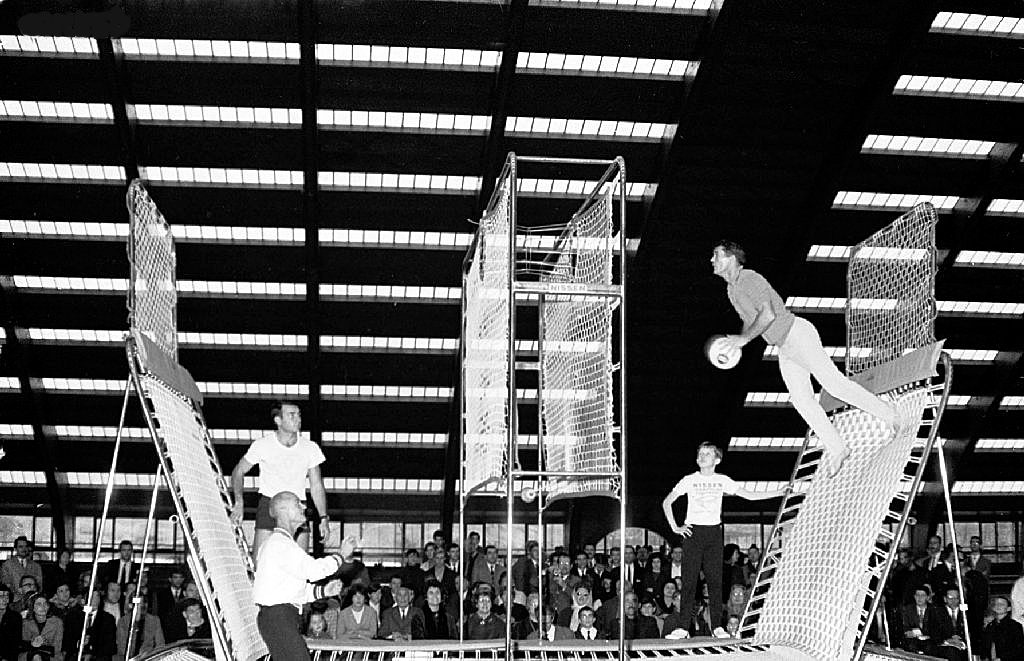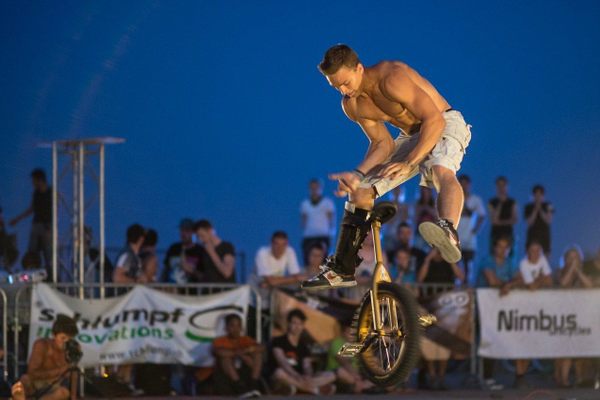The Weird, Forgotten, Awesome Sport of Spaceball
Somewhere between volleyball, gymnastics, and basketball, there is what could have been the sport of the future.

Trampolines are fun. Full stop. But spaceball looks way funner.
When he first developed the commercial trampoline in the 1940s, gymnast George Nissen thought the recreational device would take over the world. While it didn’t quite become so all-encompassing a phenomenon, his vision did give birth to countless hours of backyard entertainment, an Olympic event—and the weird, failed sport of spaceball.
Nissen built his—and the world’s—first trampoline from a sheet of canvas and rubber strips cut out of a tire inner tube to entertain the kids at a summer camp where he worked during the 1930s. The invention, predictably, was a hit among the kids, so he and some friends took their show on the road. They traveled the country and beyond, performing a comedy tumbling act, to get the word out about how fun the thing was. After landing on the term “trampoline” while doing a show in Mexico City (“trampolín” is Spanish for “diving board”), Nissen and company were able to market their rebound apparatus to schools and YMCAs all over.
He also got the military interested in trampolines to help train pilots and other personnel in the experience of weightlessness. In fact, according to an exhaustive story on the West View Trampoline Community site from 2003, Nissen sold so many trampolines to the military that he had to delay enlisting in World War II, just to fulfill the orders. By the end of the war, the trampoline had become a minor phenomenon, inspired imitation brands, and allowed Nissen to run a trampoline company full-time. He continued to travel the world to spread the gospel of the trampoline, and by the 1960s, “jump centers” began popping up across America. At these facilities people put bunch of trampolines in pits so jumpers could bound around without worrying about falling off. Nissen saw still more potential in his invention.
In the 2003 story, Nissen is quoted as saying, “If you’ve got 50 kids out there on trampolines, well, after a couple of weeks 25 of them are going to be better than the other 25. And the ones that are not so good at it drop out. Later you’ll find there are maybe 12 left. And pretty soon there’s just a hard core.” Essentially, he was concerned that kids would get bored or grow out of trampolining. His solution was to make a game of it. And lo, spaceball was born.
Nissen took his original trampoline mechanics and twisted the design into a special trampoline that acted as the game’s court. Nissen—never a fan of the common round trampoline design—made the spaceball trampoline a rectangular bouncing surface that curves up at either end, which provided the two players with an elastic backstop that they could use to propel themselves forward. In between them was a net wall with a hole in the top. The object of the game was to bounce up and toss a ball through the hole to the opponent’s side of the tramp. If he or she failed to catch it, the thrower earned get a point. Put simply, it was one-on-one, bounce-enhanced proto-volleyball.
Nissen always championed the trampoline’s effectiveness as an exercise tool. NASA ran a study in 1980 that proved that trampolining provides an excellent workout, and according to the Oxford Dictionary of Sports Studies, spaceball was based in part on techniques they were already using to train astronauts. Spaceball combined aerobic exercise and manual dexterity with balance and body control. And it still looks really fun.
Despite its appeal, spaceball never made it into orbit. Nissen demonstrated the game around the world, and at one point even got some members of the Jackson 5 to play it on television. Spaceball picked up a minor following, but it never really caught on. Nissen eventually decided that he wanted to refocus on regular trampolines, and a few other gymnastic inventions, including new kinds of pommel horses and balance beams.
A few gyms kept their old spaceball tramps around, and occasionally units are put up at county fairs. Recently, a $700, scaled down spaceball trampoline, reimagined purely as a kid’s game, was available from upscale tchotchke purveyor Hammacher-Schlemmer, though it no longer appears to be available. Other than that, spaceball has been all but forgotten.
Nissen passed away in 2010, but before he died he said that spaceball was his all-time favorite creation—despite his inability to get it off the ground. But it still has a chance. With a name like that, it may have just been ahead of its time.












Follow us on Twitter to get the latest on the world's hidden wonders.
Like us on Facebook to get the latest on the world's hidden wonders.
Follow us on Twitter Like us on Facebook